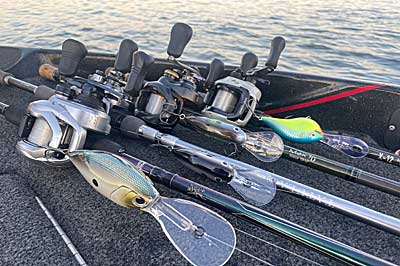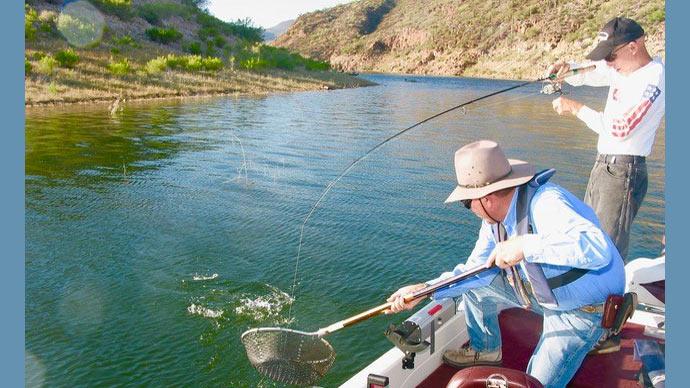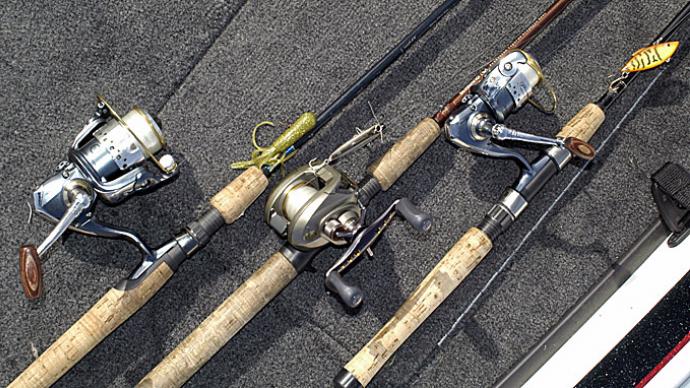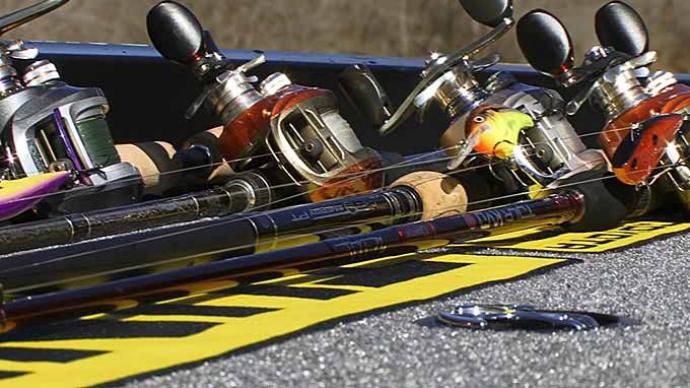| For more information: |
The right fishing rod will make you a better angler. Many anglers are unaware that the fishing rod is one of the most essential tools for catching and landing bass. How often have you gone out and only landed half of the fish that bite? What about when you thought it was a bite but weren't sure? How many bites do you miss on each outing? Are you able to make accurate casts with your rod? These are only a few things that having the right rod will help you with.
Many anglers search for answers on which rod to use for different techniques. It's much like playing golf. Each shot requires a different club. In bass angling, each type of lure requires a different rod type. This is a good one to tell your spouse, but it's also very accurate. Picking the right rod can be confusing, to say the least: fiberglass, graphite, or composite (a blend of the two), moderate, fast, or even extra-fast tapers, heavy or light, and everywhere in between. We can shed some light on the subject and help you purchase your next rod.
Types Of Fishing Rods

The fishing rod is made from either fiberglass or graphite or a blend of the two. The material is woven into what looks like sheets of cloth. The finer the weave, the faster the action. The weave is measured in modulus, and technical names and marketing terms will vary by brand.
Fiberglass rods have a smaller modulus and are less sensitive but offer other benefits. Graphite rods have a higher modulus and will be lighter and more sensitive. Composite rods fit somewhere in between and offer the best of both worlds for some techniques - more on that later.
A high modulus rod would be stiffer, faster, lighter, and more sensitive but may also be more brittle, much like the difference between Plexiglas and glass. All rod blanks are not created equal. A quality blank will be lightweight and engineered for a specific power and action. Rod designers spend many hours to achieve the right power and action and will include carbon materials to help make them lighter and stronger.
The rod components are equally as important as the rod blank itself. The rod handle can be made of many materials such as cork, EVA foam, or, similar to golf club handles, with a "grippy" texture. The handle should fit your hand comfortably and remain firm enough to carry sensitivity. The reel seat should be made of sturdy material and your reel firmly. A reel seat with a cut-out that allows the rod blank to be felt by the hand will give the angler greater sensitivity.
The guides are one of the most critical elements of the rod - and can be the costliest. A low-quality guide will ruin even the best blank. On the other hand, a high-quality, low-profile, lightweight guide will increase sensitivity and casting distance.
A rod with Fuji guides generally means quality, as they are the leader in the industry. But thankfully, all of the guide manufacturers have gotten much better over the years and will no longer become damaged by braided lines. This was a significant issue but has become much better in recent years.
Guides have also become much smaller over the years, and this has helped make rods even more sensitive and lighter. In addition, micro and semi-micro guides allow for more rod guides on each rod, which helps improve line control. This helps with more fluid casts and also helps with sensitivity.
Speaking of sensitivity, it is one of the most important factors when choosing a rod. You can better decipher what is happening with your bait with a sensitive rod. For example, how often has something happened to your bait, and you couldn't tell if it was a bite?
Graphite fishing rods are more sensitive than fiberglass rods. Still, technological advancements have made some fiberglass rods much better while eliminating some of the "dull" feel and making them better choices for some lures.
Buzzbaits And Spinnerbaits
With buzzbaits and spinnerbaits, you will be casting continuously, so a lightweight rod is necessary. Sensitivity is also essential because, many times, the fish will bump the blades before striking. A 7-foot rod will give a little more casting accuracy, but a slightly longer rod will give you more hook-setting power, leverage, and casting distance. These baits use a single hook, allowing you to put more pressure on the fish during the fight, so a medium-heavy power rod would allow enough power to land the fish. The tip needs to be flexible enough to cast the lure accurately.
Best rod: Lightweight, sensitive, 7- to 7-foot, 4-inch foot rod with a medium-heavy power and a medium/soft tip.
Crankbaits, Chatterbaits, And Topwater Lures
As spinnerbaits, crankbaits, ChatterBaits, and topwater lures require continuous casting, weight is an important factor. Sensitivity is also essential, not so much for topwater but for ChatterBaits and cranking. After you get accustomed to the bait you're using, a sensitive rod will help you determine what type of structure the bait is contacting. For example, if the fish are on a hard clay bottom and you know your lure is digging into the mud, you know you are in the wrong location and look for rocks or other fish-holding structure or cover.
A 7 1/2-foot rod is suitable for distance and casting heavier baits. A 7-foot rod is more accurate, but you may need to adjust the length to your fishing style and stature.
Many anglers prefer fiberglass or composite rods for these baits, which allows the fish time to inhale the bait before you set the hook. However, the treble hooks on crankbaits and topwater lures can dislodge if you apply too much pressure. The added flex of a fiberglass rod will keep the hooks from coming unbuttoned, but you lose some sensitivity in some instances. This makes composite blends (both graphite and fiberglass) so good for these baits because they offer the best properties of both materials. But much of this comes down to personal preference, and there is no one crankbait rod that can do it all.
A medium to medium-heavy power rod is usually fine so long as the rod has enough backbone to get a good hookset and is flexible enough to cast the lure you are using. For example, a 1/8-ounce lure needs a lighter tip, while a larger lure requires a fast tip to cast correctly.
Best all-around rod: A lightweight, sensitive, 7-foot fiberglass or composite rod with a medium to medium-heavy power, depending on the weight of the lure.
Worms And Jigs
Worms and jigs are two of the best lures for bass fishing and vary significantly from finesse worms to giant 10-inch worms and from lightweight finesse jigs to heavy-duty flipping jigs. Of course, no one rod can do it all, but there are some things you should look for when choosing a rod.
When fishing deep water, the two most important factors are sensitivity and weight. Sensitivity is crucial to feeling more subtle bites and weight because you will hold the rod up for extended periods when fishing these baits.
Use a 7- to 7 1/2-foot rod, depending on your preference and the type of structure you are fishing. Most prefer a rod approximately 7 feet long, give or take a few inches when fishing 20 to 60 feet deep, and a 7 1/2 footer when fishing 5 to 20 feet deep. Graphite rods are lighter, more sensitive, and faster and the way to go for these baits. You will want a fast or extra-fast rod with a medium-heavy backbone to get a fast hookset. It is crucial to have a soft enough tip to maintain tension on the fish at all times. When you hook a fish, only the hook's point will often be embedded, and unless you apply enough pressure, you can get slack in the line and quickly lose the fish when it gets close to the boat.
Best all-around rod: A lightweight, highly sensitive rod, 7- to 7 1/2 feet, made of graphite with a medium-heavy or heavy power and a soft tip.
Flipping And Pitching
Flipping requires holding the rod near the nine o'clock position and making a pendulum motion. Weight is vital when holding the rod up for extended periods. Flipping rods are designed for removing fish from heavy cover in shallow water.
The recommended size would be from 7- to 8 feet long. A good choice is a 7 1/2-foot rod because pitching the baits is easier. Pitching and flipping go together. Look at the tip; make sure it has some flexibility. This flexibility will make it easier for the angler to make quiet entries into the water and makes pitching much simpler when necessary.
Your flipping stick should be a lightweight graphite with a stiff backbone to pull those fish out of heavy cover. A light and sensitive rod is essential, so purchasing a better quality rod can be more important than the one you use for other techniques.
Best fishing rod: A lightweight 7 1/2-foot heavy or extra-heavy graphite rod with a stiff backbone and a medium-fast tip.
Choosing the correct rod will enhance your fishing and make each trip successful. It will help you increase your hooksets, and you'll catch more fish. These tips will save you money in the long run by keeping you from purchasing rods with little purpose in your arsenal. The right rod CAN make a difference. Give it a try!




